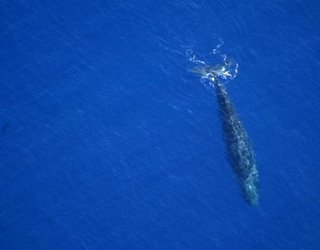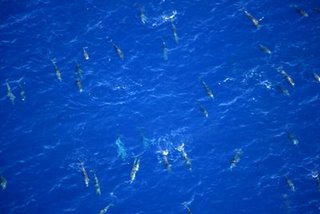
Photo by Fat Old Sod at the Xanana Republic Gazzete [1], used with permission.
The title of this article is a quote from Twitter user @BILL_ROMANOS on December the 31st [2] celebrating a discovery made by Australian and East Timorese researchers whose recent study made overwhelming findings concerning sub aquatic life: the biggest concentration ever reported of whales and dolphins, among other cetaceans, was found 50 km (30 miles) off the coast of East Timor.
With this, East Timor, as a young country with a troubled history, now has a fresh breath of hope for its promising eco-tourism industry. Once again, the strategic Wetar-Ombai [3] strait shows its value. Although it is most famous for being a route for “US nuclear and Australian navy submarines travelling through the Indonesian islands [4]“, this time the strait that separates the Pacific from the Eurasian plates is recognized as “a major migratory route for marine wildlife moving between the Pacific and Indian oceans [5]“.
Cathal Foster [6] (PT) writes about it:
A expedição, que foi o primeiro grande estudo de cetáceos em Timor-Leste, veio confirmar aquilo que os biólogos marinhos apenas suspeitavam: as águas profundas dos estreitos de Wetar e Ombai, ao largo de Timor – que podem ter até três mil metros de profundidade -, são uma importante rota migratória e corredor para a vida marinha, ligando os oceanos Pacífico e Índico.
This discovery is grabbing the attention of several digital citizens who have begun linking their blogs or tweets to mainstream news:
- O LENTE in East Timor and its Maritime Biodiversity [7] (PT)
- Margarida A [8] from Umalulik [9]in Expedition finds one of the biggest hotspots for whales and dolphins on the planet [10], and Whale and dolphins hotspot found in East Timor [11] (PT)
- Wendy Heller [12] from DivePhotoGuide.com in East Timor, Home of Whales & Dolphins [13]
- @mostrador [14] on Twitter, has called the hotspot a sanctuary (ES)
- And @greenoptions [15], @compost3r [16], @ecosfera [17], @celebritypaycut [18], @neandertal [19] have tweets about it (PT, ES and EN).
The amazing diversity of species, that choose the waters off East Timor's coast as a favourite “hotspot”, is occasionally mentioned by bloggers. Fat Old Sod [20], at the beginning of November 2008, posted some “Mega Fauna” pictures he took from an aircraft trip over Timorese waters:
Mega Fauna basically means anything bigger than, and including, turtles. (…) We saw at least 6 species of whales, easily over 4000 dolphins, manta rays in formation, BIG hammerhead sharks cruising on the surface and we just stopped counting the turtles once we got to Com and beyond because there were too many.

Photo by Fat Old Sod at the Xanana Republic Gazzete [1], used with permission.
An anonymous comment [21] on the post titled Whale and dolphins hotspot found in East Timor [11] (PT) states:
Mais um grande ponto para a futura indústria do turismo em Timor.
Bem regulamentado poderá ser mais uma grande fonte de rendimento para o país.
Levi Novey [22], however, is concerned [23]:
It highlights the need for greater protection of biodiverse ocean areas like these from unregulated fishing – a challenge given East Timor’s desire to develop their fishing industry.
The fishing regulations appear to be an issue for the preservation of the fauna found, as they are commonly ignored, giving space for illegal fishing to occur in those waters. Fat Old Sod [20] caught fishers red handed with his camera:
We also got pictures of some illegal fishing boats from Indonesia which we have handed on to the appropriate authorities with times, name of vessel, location etc.
Edy, a Timorese citizen, commented [24] on the discovery, raising some interesting points on the conditions those waters offer to marine life:
(…) the marine environment in that area in (sic) certainly more secure, cleaner, and quieter for those mammals to gather even perhaps can be used as their marine habitat to reproduce and expand. Giving the fact that in that maritime area there is less fishing activity in industrial scale and it’s not considered strategically good enough for commercial ship’s and military navals passage hence almost inexistence in that area any noise that can be prejudicial for whales and other species. Therefore it’s a hotspot for those marine animals to live in abundance. Any habitat of other species when given time, space, less disturbances from human greedy commercial and military activities will certainly find its own way to live, survive, reproduce and expand in greater numbers to the benefit of all living things in this planet we call Earth.
Back in his post Whale Of A Time [1], Fat Old Sod [20] says how lucky he felt to be asked to fly over the spot, take pictures and be witness to such a special thing:
I knew we had great marine life here but I never knew it was so prolific. The two scientists I was with told me that it was an absolutely exceptional survey. And when a scientist starts to use long adjectives you know you've seen something special!!

Photo by Fat Old Sod at the Xanana Republic Gazzete [1], used with permission.
For more breathtaking pictures of marine life in East Timor, check these web addresses: